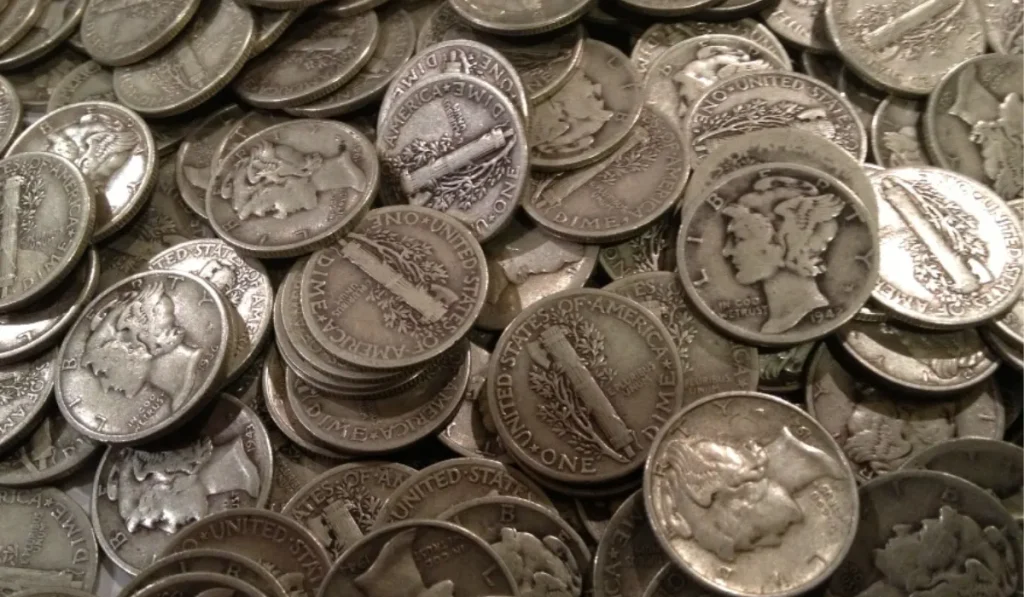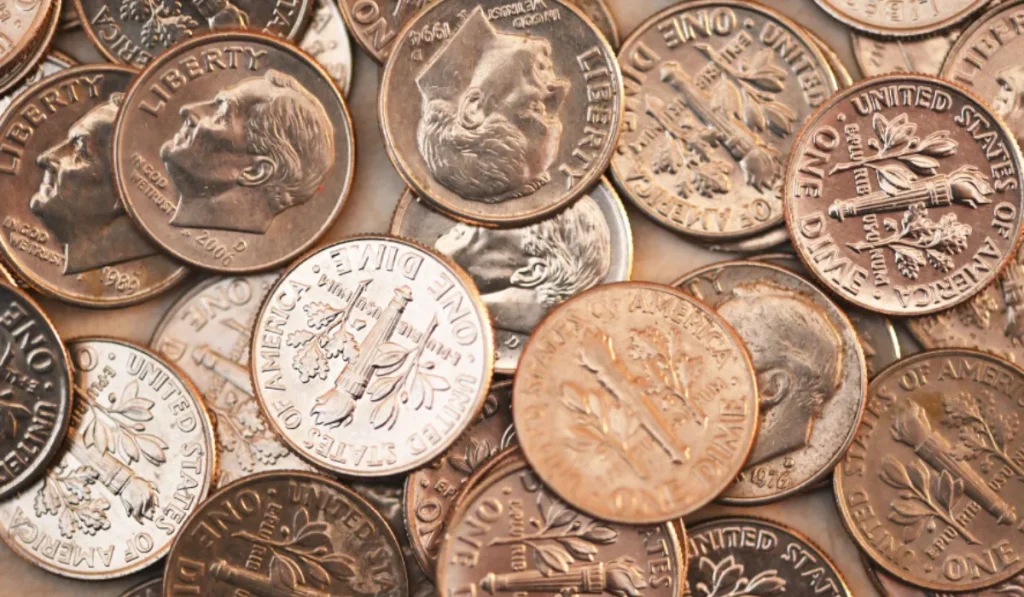A Mercury dime weighs 2.5 grams. This silver coin was minted from 1916 to 1945.
The Mercury dime, also known as the Winged Liberty Head dime, is a piece of American history valued both by collectors and investors.
Named for its obverse depiction of a young Liberty donning a winged Phrygian cap, the design often leads to the misconception that it represents the Roman god, Mercury.
These dimes, composed of 90% silver and 10% copper, are sought after for their precious metal content as well as their numismatic value.
Coin enthusiasts often assess the condition, rarity, and historical context, which can greatly influence the coin’s market value.
As a staple in the world of coin collecting, the Mercury dime symbolizes an era of American coinage admired for its beauty and craftsmanship.
The Mercury Dime Defined
The Mercury Dime, also known as the Winged Liberty Head Dime, stands out in American coinage.
Struck by the United States Mint from 1916 to 1945, this ten-cent piece captures the essence of early 20th-century design and liberty. These dimes weigh approximately 2.5 grams and are made of 90% silver and 10% copper. Collectors and historians alike cherish them for their beauty and historical value.
Iconic Design Features
The obverse of the Mercury Dime features a striking image of Liberty. Instead of a standard portrait, Liberty dons a cap with wings, symbolizing freedom of thought.
On the reverse, you’ll find a fasces and olive branch, representing America’s military readiness and love for peace. Each design feature of this dime serves a purpose, reflecting a nation’s ideals in a small yet potent symbol.
Historical Significance
Mercury Dimes are not just pieces of currency; they are snapshots of history. Introduced just before the U.S. entered World War I, they circulated during significant periods such as the Roaring Twenties, the Great Depression, and World War II.
These dimes have witnessed the ebb and flow of American life, making them a tangible link to the past that continues to fascinate collectors and historians.
Specifications And Composition

An understanding of the Specifications and Composition of the Mercury Dime is crucial for collectors and enthusiasts. These small silver coins carry historical importance and value. Let’s dive into the materials that make up this coin and its precise measurements.
Materials Used
The Mercury Dime, minted from 1916 to 1945, contains 90% silver and 10% copper. This blend gives the coin durability and its signature luster. The precious metal content contributes to the coin’s collectible status and intrinsic value.
Dimensions And Measurements
The exact weight of a Mercury Dime is 2.50 grams. With a diameter of 17.9 millimeters and a thickness of 1.35 millimeters, its size is easy to handle for trade and collection purposes.
| Attribute | Specification |
|---|---|
| Weight | 2.50 grams |
| Diameter | 17.9 mm |
| Thickness | 1.35 mm |
| Composition | 90% Silver, 10% Copper |
Weighing The Mercury Dime
Weighing the Mercury Dime invites you to dive into the world of coin collecting. It’s vital to know the details. A coin’s weight tells its story, from its creation to its journey through history.
Standard Weight
The Mercury Dime, produced between 1916 and 1945, stands as a classic American coin. Minted with precision, each dime originally weighed 2.50 grams. This weight is standard for coins of this series, crafted from 90% silver and 10% copper.
Factors Affecting Weight
Several factors can alter the weight of a Mercury Dime:
- Wear and Tear – Circulation can reduce a coin’s weight over time.
- Environmental Damage – Elements like water and air can corrode the coin, affecting its weight.
- Improper Handling – Scratches and dents from drops or mishandling can chip away its mass.
Collectors assess these factors to determine the coin’s value, authenticity, and story.
Collecting Mercury Dimes

Mercury dimes spark excitement among coin collectors. These small silver pieces, minted from 1916 to 1945, represent a bygone era.
Their iconic design features the mythical god, Mercury, making them a standout collectible. The precision of detail and the historical value cause collectors to seek them eagerly.
Evaluating Condition
Condition plays a pivotal role in the value of Mercury dimes. Collectors should assess the following factors:
- Wear and Tear – Check for smooth surfaces where details may have eroded.
- Luster – A coin with its original luster is typically more desirable.
- Strikes – Full, crisp strikes that show complete design details elevate a dime’s appeal.
- Damage – Dents, scratches, or cleaning can significantly diminish value.
Determining Value
Several factors influence the value of a Mercury dime:
- Rarity – Key dates and mint marks can command higher prices.
- Condition – As mentioned above, a coin’s state greatly impacts its value.
- Metal Content – Each Mercury dime contains 90% silver, contributing to its intrinsic value.
- Market Demand – Current collector demand can shift value.
Coin experts use grading systems to classify condition. These range from Good (G) to Mint State (MS), with specific grades like Fine (F), Very Fine (VF), and Extremely Fine (XF) describing intermediate conditions.
| Grade | Description | Value Impact |
|---|---|---|
| G (Good) | Heavy wear, main features visible | Lower Value |
| F (Fine) | Moderate to considerable wear | Moderate Value |
| VF (Very Fine) | Light to moderate wear | Higher Value |
| XF (Extremely Fine) | Very light wear, sharp features | Very High Value |
| MS (Mint State) | No wear, original luster | Highest Value |
Knowing the weight of a Mercury dime is critical. It should weigh 2.5 grams. Dimes underweight may be worn or tampered with, affecting collectibility and value.
Preservation And Handling
Collectors of coins, like the Mercury Dime, know that proper care ensures lasting value. A Mercury Dime, with a weight of 2.50 grams, needs careful handling.
Proper Storage Techniques
Keep your Mercury Dimes in a safe environment. Humidity and extreme temperatures can damage coins. Use coin holders made of inert materials. These are non-reactive cases that protect from scratches and dirt.
- 2×2 holders – These provide visibility and protection.
- Albums – Organize your collection without handling the coins.
- Slabs – For high-value coins, professional grading and encapsulation is best.
Cleaning And Maintenance
It’s tempting to clean a Mercury Dime to make it shine. But, cleaning can devalue the coin. It’s important to leave the natural patina. Chemical cleaners and abrasive cloth should never touch your coin.
| Do | Don’t |
|---|---|
| Handle the edge, not the face. | Use harsh chemicals. |
| Use gloves to avoid oils from skin. | Rub or polish the surface. |
| Store in a cool, dry place. | Expose to extreme temperatures. |
Follow these guidelines to ensure your Mercury Dimes remain in prime condition for years to come.
Legal And Historical Considerations
The Mercury Dime, minted in the United States from 1916 to 1945, remains a topic of fascination. Key legal directives and historical contexts played vital roles in its production and current status in numismatic collections.
Legislation Impact
Congressional acts set the weight and composition of coinage. The Mercury Dime, officially known as the Winged Liberty Head Dime, stands as a testament to this.
- Designed by Adolph A. Weinman, its production obeyed the Coinage Act of 1873.
- The act mandated dimes to weigh 2.50 grams, ensuring uniformity.
- Made of 90% silver and 10% copper, these dimensions have historical significance.
Role In American Numismatics
The Mercury Dime plays a pivotal role in American currency history. Collectors highly prize these coins for various reasons:
- They signify early 20th-century American coinage.
- Scarce dates and mint marks, like the 1916-D, incite collector’s enthusiasm.
- Exceptional artistry and design make it a cherished item.
| Year | Weight | Composition |
|---|---|---|
| 1916-1945 | 2.50 grams | 90% Silver, 10% Copper |
Overall, the Mercury Dime weaves an intricate narrative full of numismatic lore and legislative importance. Its weight reflects the technical expectations and standards of its time, making it more than just a piece of metal—it’s a slice of American history.
FAQs About the Weight of A Mercury Dime
What Is The Standard Weight Of A Mercury Dime?
The standard weight of a Mercury Dime is 2. 50 grams. It contains 90% silver and 10% copper, which contributes to its weight.
How Much Does A Mercury Dime Silver Content Weigh?
The silver content in a Mercury Dime weighs approximately 2. 25 grams. This is because the dime is made of 90% silver.
Are Mercury Dimes Made Of Pure Silver?
No, Mercury Dimes are not made of pure silver. They consist of 90% silver and 10% copper, which was standard for U. S. dimes until 1965.
Do Mercury Dime Weights Vary By Year?
Mercury Dime weights remain consistent at 2. 50 grams for coins minted between 1916 and 1945, barring any significant wear or damage that might affect the weight.
Conclusion
Understanding the weight of a Mercury dime is crucial for collectors and sellers alike. At 2. 5 grams, these coins are not just historical pieces but valuable assets. Remember, condition and rarity can affect value too. Keep an eye out for these tiny treasures—your collection’s weight is worth its measure in history and potential gain.
Happy collecting!
Resources:
https://www.cfa.gov/about-cfa/design-topics/coins-medals/mercury-dime
https://www.usmint.gov/coins/coin-medal-programs/centennial-gold-coins/mercury-dime
